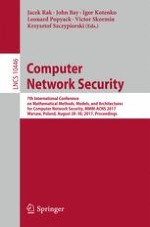2017 | OriginalPaper | Chapter
Malware Analysis and Detection via Activity Trees in User-Dependent Environment
Authors : Arnur Tokhtabayev, Anton Kopeikin, Nurlan Tashatov, Dina Satybaldina
Published in: Computer Network Security
Publisher: Springer International Publishing
Activate our intelligent search to find suitable subject content or patents.
Select sections of text to find matching patents with Artificial Intelligence. powered by
Select sections of text to find additional relevant content using AI-assisted search. powered by
